The Ball-of-Light Particle Model describes all elementary particles as standing, spherical waves composed of three fields: electric, magnetic, and gravitational. (The vector G is not equal to the gravitational constant G, or the lower case "g" as in F = mg.) The central equation: E cross B = G
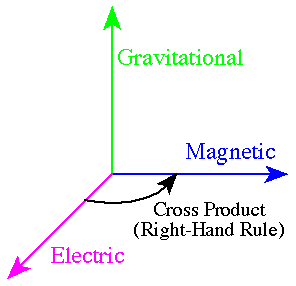
emphasizes the already known fact that the electric, magnetic and gravitational force fields act at right angles to each other. (An easy way to imagine this is picture the corner where two walls meet a ceiling.) The relationship between these three fields has been known to exist and is expressed in a widely accepted physics equation known as the "Poynting Vector".

The Poynting Vector "S" is expressed in terms of the Electric and Magnetic fields. However, note the units can be reduced to kilograms per second cubed! This equation expresses mass in terms of the electric and magnetic concepts. What is "new," so-to-speak, is to integrate the cross product -- E cross B -- over the surface of a sphere to obtain mass or gravity. (This relationship can be seen in Table A.)
(This page contains information that is not in the book, "The solution to the question, "What is time?" This information has been submitted to the journal Physical Review -- in 1995 -- and is on record with that publication under the name, "Ball of Light Particle Model." Until this paper has been published with Physical Review -- or another journal -- this information will remain: copyrighted (1995) by John T. Nordberg -- all rights reserved.)
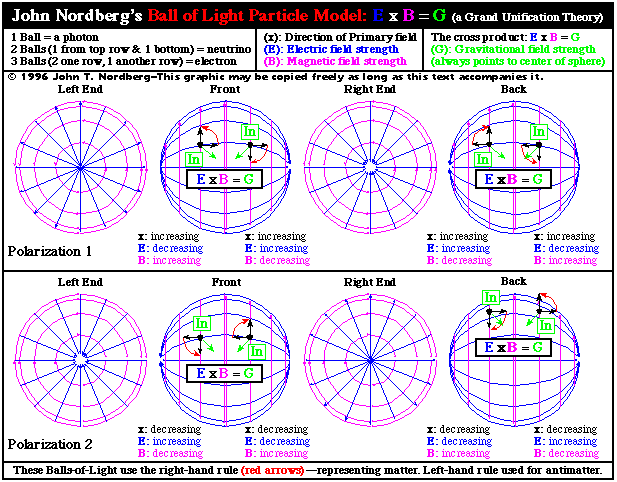
Understanding this table is the most important step that someone must undertake in order to understand the Ball-of-Light Particle Model.
Details to notice include:
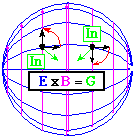

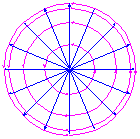
(Left end of first ball of light in Table A)
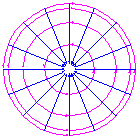
(Right end of first ball of light in Table A)
Table A is only one fourth of a much larger graphic -- Table B. Table B is too large to make a convenient Internet graphic. To see each portion, click in the table below.
|
|
|
|
|
|
If the Ball-of-Light Particle Model is correct, then what do the 4 quadrants of Table B represent? I believe that one quadrant represents matter, one represents antimatter, and the other 2 quadrants represent "matter" and "antimatter" in another, opposite half of the universe! Our part of the universe seems to use the electric field as the primary field and the most matter behaves with the right-hand rule. There must be another half of the universe that follows the left-hand rule. In essence, everything there has an opposite spin.
There is a lot of speculating that could be done here. However, the key thing to notice in Table B are the symmetries. They are everywhere! If the Ball-of-Light Particle Model does not describe nature, then it would be natural to ask why? My first impression was, this has to be it!
Now, back to basic rules of science. Does the Ball-of-Light Particle Model match up with any observations in physics? Yes. Particle Physics? Yes. How about astronomy? Yes. Are there any situations -- any observations -- that contradict the Ball-of-Light Particle Model? I haven't discovered one yet.
What should we talk about next? There are so many possibilities. What is a photon? What is a neutrino? What is an electron? Before getting to these questions, the key area, will be something called superposition. It deals with adding these balls-of-light together. In other words, what happens when one of the balls-of-light meets another ball-of-light?
Ask yourself, what would happen if two of these waves of electromagnetic and gravitational fields were combined? Some of the fields could add to each other. Some of the fields could subtract from each other.
Imagine waves in water. What happens when two waves superimpose? Their heights add. What happens if the two waves our out phase? They subtract.
Graphic of waves
In symmetrical situations, equal and opposite electrical or magnetic fields would attract each other. In nonsymmetrical situations, the fields would repulse each other, or, create a disturbance that could destroy the particle.
The gravitational fields of two spherical waves would always combine to make the two particles more stable.
Equal and identical electrical or magnetic fields would create situations where the two balls-of-light would repel each other and never perform a superposition. In other words, they could not add because they couldn't combine in a stable manner.
The Ball-of-Light Particle Model does not reject all of previous physics. It builds on it. However, some areas of previous physics must be refuted.
Relativity is the key area. It needs to be completely thrown out.
The standard model for an atomic nucleus, while not completely refuted, must be modified significantly. Every student of science has had it pounded in to them that atomic nuclei are collections of protons and neutrons held together by the strong force. The Ball-of-Light Particle Model predicts atomic nuclei are spherical balls-of-light that are held together by a strong combination of three forces: electric, magnetic, and gravitational.
The standard model for the star and galaxy formation needs to be completely redone. The Ball-of-Light Particle Model predicts they are decaying balls-of-light rather than collapsing clouds of primordial hydrogen and helium.
The standard model for cosmology, the Big Bang, also needs significant reworking. Instead of expanding from a singularity, the universe is expanding from an exploding ball-of-light.
Furthermore, I believe the Ball-of-Light Particle Model predicts that the matter and energy of the Big Bang are expanding in space, rather than space "itself" is expanding.
Pick up a billiard ball. It seems solid. Cut it in half. It looks solid. But looks are deceiving. At the atomic level the atom is mostly void. There is a central nucleus, and it is surrounded by orbiting electrons. Thus, the billiard ball is mostly void.
graphic of atom
Can you cut an electron in half like the billiard ball? Is it solid? It is impossible to "see" an electron. We "see" by reflecting photons off objects. However, photons can interact with electrons. Thus, there is no way to visually "see" the structure of an electron.
Can you cut a nucleus in half? In general, the answer is yes. Can you "see" its structure? In general, no. It is only possible to visualize atomic nuclei. Presently, the nuclei of atoms are visualized as "clusters" of separate particles, called protons and neutrons, that are held together by the "strong" force -- with the exception of the nucleus of the Hydrogen atom which has just one proton. The Ball of Light Particle Model differs from this traditional view of nuclei. The Ball of Light Particle Model describes all elementary particles -- including traditional atomic nuclei and photons -- in terms of a spherical, 3-dimensional wave of Electric, Magnetic, and Gravitational fields. Since the Ball-of-Light Particle Model treats elementary particles and nuclei as being "built up" from just photons, this particle model can be summarized as describing all elementary particles as "Balls of Light." (A minor aspect of this particle model, is it predicts the centers of these balls of light are voids -- the electric and magnetic fields are just on the surface of the spheres.)
Both, the traditional particle model, and the Ball-of-Light Particle Model can never be proven. Since there is no way to see the structure of the particles described, they can only be supported by inductive reasoning.
In Table A, in the top row of spheres, is a sphere labeled, "Front." By itself, one of these spheres represents a photon. Key aspects of this sphere are:
To see how a photon moves, examine the following graphic.
Animation of photon moving.
Examine the two spheres in Table A labeled "Front" -- in both the top and bottom rows. Notice how they have:
This particle model hypothesizes, if these two photons are superimposed, they will no longer have "translational" motion. Their fields would interact -- creating a "standing wave." The particle that would be formed would:
These characteristics closely match current descriptions of neutrinos. This particle is called the "second harmonic."
This particle model hypothesizes, a third photon can be superimposed on a neutrino. The particle that would be formed would:
These characteristics closely match current descriptions of electrons. This particle is called the third harmonic.
Both photons and electrons can have two polarizations in this model. Two combinations of the polarizations are compatible. Two are not. Whether they are or not is simply determined by the rotational direction of the magnetic fields. If the magnetic fields attract, then the photon can combine with the electron. If the magnetic fields repel, then the photon can not combine with the electron.
If the photon and electron can combine, then the next issue is the magnitudes of their respective wavelengths -- the diameters of the spheres. If the wavelength of the photon is an exact multiple of the electron, then the photon will "add to", or "combine with" the electron. This would create a harmonic particle. This would predict that electrons can not have any energies, but rather, distinct energies.
If the photon and electron have correct polarizations, but the wavelength of the photon is not an exact match, then the photon will still wrap itself around the electron. However, since the photon's wavelength is not an exact match, the resulting particle is not harmonic. After the wrapping has progressed as far as it can, there would be a fraction of the photon left over (sort of like a tail). The fields in this tail of the photon would repel the photon from surface of the electron. The photon could not stay combined with the electron, so it, or a fraction of it, would then unwrap itself from the electron and travel off in another direction. The important implications for this are:
There is only one upper limit for further combinations of particles -- for further harmonics. It is the total Mass (or, Energy) of the universe. Thus, this particle model predicts that just prior to the "Big Bang," all of the energy of the universe was contained in one, massive, spherical, harmonic, ball of light. Thus, it is disagreement with a Big Bang from a "singularity."
Furthermore, the cores of stars, Cepheids, Quasars, black holes and other objects are spherical standing waves of electromagneticgravitational energy. This would address a whole host of unsolvable problems in astrophysics. These will be addressed, later on future web pages.
Review a Ball of Light in Table A once more. Note that the Electric and Magnetic fields are acting at right angles to each other. One field is moving at the speed of light in one direction, the second field is moving at the speed of light, at a right angle to the first, in another direction. This, of course, is "c" squared. The "E" in E = mc2, is the energy of the Electric Field cross the Magnetic Field. This cross product has to be equivalent to the mass on the other side of the equation. With our system of units, the speed of light is not defined to be "1," rather as, 299,792,458. If the speed of light was defined as "1," then this equation would be an identity -- E = m. Only because of the system of units which scientists have chosen to use, the left side must be divided by "c" squared (Electric cross Magnetic divided by "c" squared) to be equivalent to mass.
Perhaps the two most important observations ever made in physics are:
Again, review one of the spheres in Table A. The electric and magnetic fields in the spheres can be broken down, mathematically, into parallel "loops." If one of these particles is stationary, then any one of these loops would have a constant value around its circumference for its Magnetic field or Electric field. However, if the particle is accelerated -- IN ANY DIRECTION -- then there will be an induced field set up around loops -- perpendicular to the direction of motion -- that would inhibit the acceleration of the particle. If the induced field was electric, a perpendicular magnetic field would also be created. If the induced field was magnetic, a perpendicular electric field would also be created. The cross product -- Electric cross Magnetic -- would immediately increase. This would manifest itself as mass. Thus, F = ma can be derived from this particle model. If a ball of light has a force applied to it, it will be accelerated in some direction, inducing greater electric and magnetic fields around the surface of the sphere, inducing a greater cross product. Integrating this increasing gravitational force over the surface of the sphere gives the result of mass.
In the description of the neutrino, imagine trying to pull apart the two photons that make up the particle. The electric and magnetic fields combine perfectly -- the gravitational fields add. There is nothing that would make this particle want to spontaneously decay. It would be the perfect standing wave. The combination of the Electric force, the Magnetic force, and the Gravitational force -- as described in this particle model -- is the Strong force. (For a more detailed description see also, Strong Force)
Note the two hemispheres in the first three harmonics are perfectly symmetrical. You can split the surface of the sphere into smaller increments however. This is how further harmonics would be described.
If the pattern of Electric and Magnetic fields on the surface of the spheres in this Ball of Light Particle Model meet certain restrictions, then the resulting particle is said to be harmonic. If the pattern of the Electric and Magnetic fields do not meet these restrictions, then the particle is said to nonharmonic, and will spontaneously decay. The restrictions for a harmonic particle are assumed to be:
(See also, Decay Modes)
If a particle has a nonsymmetrical pattern of alternating Electric or Magnetic fields, then this asymmetry travels around the sphere. (An analogy would be the way a crack propagates through glass.) As the asymmetry travels around the particle, it would induce Electric and/or Magnetic fields that would "pinch" the particle. As the particle "splits," "decays," however described, the result would be either new particles and/or photons. If the new particles, are not harmonic, then their asymmetries would cause further decays. Such cascades of decays predicted by this particle model are in total agreement with all known observations of decays.
This particle model would also predict that two separate particles could pass within close distances to each other and induce decays -- without coming into contact -- a known phenomenon.
This particle model would predict that as a particle's motion, with respect to the speed of light, is increased, the induced Electric and Magnetic fields would cause the particle to become smaller. This particle model places the phenomenon called "length contraction" in the particle, gives it a common sense cause, a predicts it a priori. The increase in speed causes induced Electric and Magnetic fields. The increase in the Electric and Magnetic fields causes induced gravitational force. The induced gravitational force cause the Electric and Magnetic fields to collapse to a smaller size -- all a priori -- nothing beyond 3 dimensions, no warping of space, no a posteriori reasoning.
There is a known particle called the muon. At rest, on earth, it is known to be unstable. It typically decays in about 2.2 microseconds. This particle model predicts that the cause for decay, is on the surface of the particle, there is an asymmetrical region either an Electric or Magnetic field. If this particle is accelerated, the increase in speed will induce the Electric and Magnetic fields across the whole particle to increase, inducing greater gravitational force, holding the particle together with greater force. The asymmetry is still there, however, the forces it must generate to split the particle and cause decay are greater. Accelerating a particle will improve its stability. The particle does not "live" longer because of "time dilation." It simply is more stable. Time still progresses at the speed of light.
Conversely, a particle that is not stable to begin with will become less stable as it slows down. Simply slowing a particle will cause it decay more rapidly, potentially spewing out all sorts of radiation in the form of photons or more stable Balls of Light. This is a known phenomenon called "Breaking Radiation," or, "Bremsstrahlung" radiation.
If you have studied the preceding material, reading this section is unnecessary. To recap, accelerating an elementary particle, as described in the Ball of Light Particle Model, causes induced Electric and Magnetic fields on the surface of the sphere. The cross product of the Electric and Magnetic fields gives greater Gravitational field. Integrated over the surface of the sphere, the elementary particle would have greater mass. Again, all a priori -- nothing beyond 3 dimensions, no warping of space, no a posteriori reasoning.
One of the most important implications that the Ball of Light Particle Model has for physics is it makes the gravitational force law dynamic.
The further away an object is from earth, the further back in time we see it. If an object is further back in time, then it is closer to the Big Bang -- assuming such an event occurred. Assuming an event such as the Big Bang occurred, it makes sense to assume that particles of mass that are products from this explosion slow -- due to gravity -- the further away from the explosion they travel. As a general rule, if you are close to the center of the Big Bang, then you are traveling faster than if you are further from the center of the Big Bang. Thus, in general, the further away a star or galaxy is from earth, the faster it is moving, due only to the fact we are now seeing it as it was further back in time. Using the Ball of Light Particle Model, with its dynamic treatment of gravity, it is safe to assume that: the further a star or galaxy is away from earth, the further it is back in time; the further an object is back in time, the faster it was traveling; the faster it was traveling, the greater it was its induced gravitational forces. Thus, the Ball of Light Particle Model explains the "missing mass" of the universe.
(See also the detailed description of the Missing Mass of the Universe and Dark Matter)
You might wish to perform this simple experiment to confirm for yourself how the electric and magnetic fields interact over the surface of a sphere. You will need the following:
The steps are:
This experiment proves that as the primary field -- in this case the electrical field -- sweeps over a sphere, it induces magnetic fields that change direction from one hemisphere to the other.
[Note: the effects described in this experiment -- the deflection of the compass -- are visible primarily due to the alignment of electrons in the conducting sphere. The observed fields are not pure electric or magnetic fields as described on the surface of the spheres in the Ball of Light Particle Model. A more advanced description of this experiment will be added to this site someday.]
There is a reference to "electromagnetic mass" on page 56 of Atomic Physics by Max Born (Dover Publications, Inc. ISBN 0-486-65984-4). This theory was developed by such renown physicists as: J. J. Thomson, 1892; Heaviside and Searle, 1885; Kaufman, 1906; Abraham, 1903; and Hasenohrl, 1906. (I have not been able to find out and more about their research. If you do know of their research, please E-Mail me.) Readers may be interested to know that what stopped development on this promising theory was Einstein's Relativity.
The closest thing to the Ball of Light Particle Model in currently accepted physics theory is the Poynting Vector -- named after John Henry Poynting (1852-1914). The Poynting Vector "S" is defined as:
![[Missing Graphic] (14k) The Poynting Vector--(1/mu naught) * E cross B.](../gifs/Poynting_Vector.gif)
The units for the Poynting Vector -- -in SI Derived Units -- are expressed as watts/meter2. Or, expressed in SI Basic Units: kg/s3 (kilograms divided by seconds cubed). This is extremely revealing. On one side of the equation you have Electric cross Magnetic, and on the other side you have the units of mass. The Poynting Vector is a Grand Unification Theory! To simplify its use in calculations, examples usually appear in reference to cylindrical spaces -- not spherical spaces. [If you are aware of a company that makes resonant harmonic cavities -- especially, spherical resonant harmonic cavities -- please E-mail John Nordberg.]